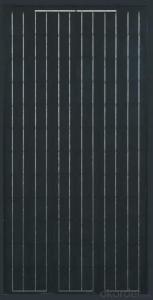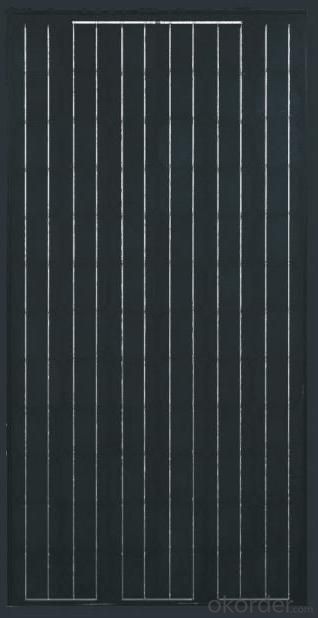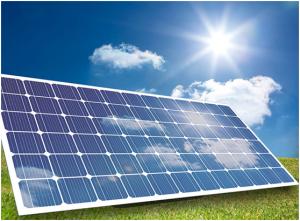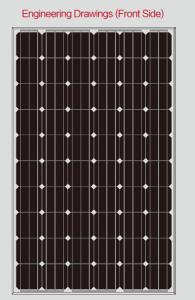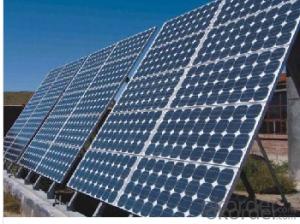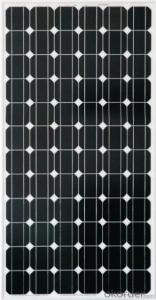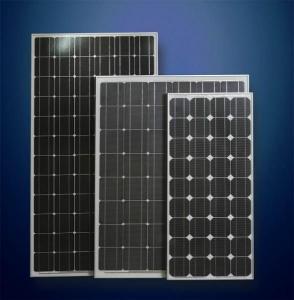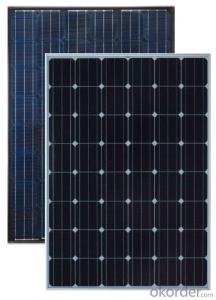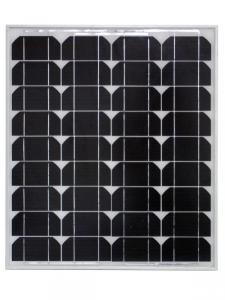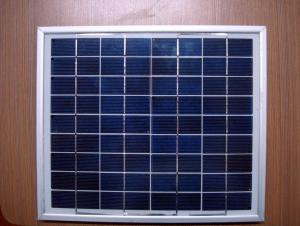Hydrogen Solar Panels - Monocrystalline Solar Module 192w
- Loading Port:
- China Main Port
- Payment Terms:
- TT OR LC
- Min Order Qty:
- -
- Supply Capability:
- -
OKorder Service Pledge
OKorder Financial Service
You Might Also Like
Solar Monocrystalline (210W-225W)
Introduction of Solar Monocrystalline (210W-225W)
Solar modules use light energy (photons) from the sun to generate electricity through the photovoltaic effect. The majority of modules use wafer-based crystalline silicon cells or thin-film cells based on cadmium telluride or silicon. The structural (load carrying) member of a module can either be the top layer or the back layer. Cells must also be protected from mechanical damage and moisture. Most solar modules are rigid, but semi-flexible ones are available, based on thin-film cells. These early solar modules were first used in space in 1958.
CNBM Solar photovoltaic (PV) Panel is designed for large electrical power requirements. It is the optimal choice for both on-grid and off-grid power systems. CNBM Solar panel offers high performance of power per square foot of solar array. Monocrystalline silicon(c-Si): often made using the Czochralski process. Single-crystal wafer cells tend to be expensive, and because they are cut from cylindrical ingots, do not completely cover a square solar cell module without a substantial waste of refined silicon. Hence most c-Si panels have uncovered gaps at the four corners of the cells.
Characteristics of Solar Monocrystalline (210W-225W)
I. Solar Cell : High efficiency crystalline solar cell. Even if under the weak light, the solar module can produce maximum power output.
II. Tempered glass (toughened glass): Anti-reflecting coating and high transmission rate glass increase the power output and mechanical strength of solar module.
III. EVA and TPT: Using high quality EVA and TPT to prevent destroying and water.
IV. AI frame: Without screw, corner connection. 6 holes on the frame can be installed easily.
V. Junction box: Multi function junction box with water proof.
VI. Long lifetime: ≥25 years; Less power decrease.
VII. Good performance of preventing from atrocious weather such as wind and hails.
VIII. Resisting moisture and etching effectively, not effected by geology.
IX. The certificate issued by international authority: UL, TUV, IEC, VDE, CE.
Standard Test Conditions of Solar Monocrystalline (210W-225W)
The opto-electrical specifications shown below are stabilized values being measured at Standard Test Conditions, Irradiance: 1000W/m2, Spectrum: AM1.5 at 25°C, The info below is subject to manufacturing tolerances. Where appropriate minutes of measurement are available and are used for the dimensioning of the installation.
Advantages of Solar Monocrystalline (210W-225W)
• CNBM Solar performance guarantees for 25 years
• 10 years guarantee for workmanship
• Timeliness of delivery
• Quality Products certified (TÜV, UL, CE, VDE, ISO)
CNBM International Corporation's products including Monocrystalline Solar Panel, Polycrystalline Solar Panel have received and enjoyed famous reputation in many countries and regions in the world .As a solar panel manufacturer in China, we strive to provide our customers with excellent service, superior products and unmatched value.
- Q: Can solar panels be installed on data centers?
- Yes, solar panels can be installed on data centers. In fact, many data centers are incorporating solar power as a sustainable energy source to reduce their carbon footprint and lower energy costs. The large, flat rooftops of data centers provide ample space for solar panel installations, making it a viable option for generating clean and renewable energy for these facilities.
- Q: How do solar panels affect the overall energy security of a building?
- Solar panels can greatly enhance the overall energy security of a building. By harnessing the sun's energy, solar panels provide a reliable and sustainable source of electricity. This reduces a building's dependence on traditional energy sources, such as fossil fuels, which are finite and subject to price volatility or supply disruptions. Solar panels also contribute to grid resilience, as they can continue generating power even during power outages. Consequently, incorporating solar panels into a building's energy mix can enhance its energy security by diversifying its energy sources and promoting self-sufficiency.
- Q: How do solar panels affect insurance premiums?
- Solar panels can potentially lead to a decrease in insurance premiums as they are considered to be a low-risk investment that adds value to a property. However, the exact impact on insurance premiums may vary depending on factors such as location, system size, and the insurance provider's policies.
- Q: Can I add more solar panel let say up to 200 watt and adding two 2 volts battery using the same charges controller and power inverter?
- If you put a black panel on the ground or on your house and don't connect it to anything, it will absorb solar energy (heat) during daylight and release it at night (radiation). Not exactly. Assuming the black panel establishes an equilibrium temperature, it's going to be losing exactly as much heat as it's receiving during the day. Some will radiate out into space, some will conduct or convect into the atmosphere. As a wild guess, maybe 50/50. If you hook up a solar panel in the same place but hook it up to batteries, charge the batteries during sunlight hours and using that energy to electrically heat the home at night. The panels will absorb solar energy during the day but will convert that to electrical energy in the batteries instead of radiating it back into space at night. The panels are only about 4% efficient, so it's the same situation as the pure black panel for 86% of the energy. The remaining 4% will get stored in the batteries and then converted to heat at night. That heat will eventually leak out of the house and warm up the Earth a tiny bit. I think it's much the same situation either way. With the black panel the energy gets radiated / conducted/convected right away. With the solar panel a small percentage is stored and not so much is radiated, mostly conducted and convected. You're partly right as a black panel is going to radiate more into space than a house. But you're taking about maybe some day about 4% of % of the differening radiation/convection/conduction fraction, of the Earth's surface area. Probably not significant.
- Q: I am fairly new to the solar panel scene, and am eager to try to set one up myself instead of buying a kit. I am looking for a solar panel that puts out 00 Watts or more, and can produce more than 20 volts. Thanks
- a cheap one that doesn't burn up
- Q: Can solar panels be installed on swimming pools?
- Yes, solar panels can be installed on swimming pools. These panels can help heat the pool water using solar energy, reducing the need for traditional heating methods and lowering energy costs.
- Q: We are looking in to buy solar panels for our house. The payment has to be around or under $4000. Our house is a 4 bedroom and 3 bath 2-story house. (Around 2500 sq. ft.) Where can we get the solar panels? Also: Will it heat our water? When we get the solar panels, what direction do they have to be facing?
- The crisis is that it's so high priced to have mounted and as you assert it's going to take decades earlier than you honestly begin saving above what the install rate used to be, I for my part might now not cross forward and make that kind of funding, it might be extra lucrative to hold the cash in a constructing society, get the curiosity from it and use that to pay to your electrical energy however the important factor that I have towards sun Panels is that until you keep in that condo for a minimum of twenty 5 years you'll now not succeed in the factor in which you're saving and to capitalise on it you might need to keep there for decades extra, so you'll now not have the choice of relocating condo with out wasting your funding and on the second having sun panels does now not develop the significance of the estate, it's only a well promoting factor, while you purchase your new condo, you might commonly need to begin everywhere once more after which given that of the years will on no account reside lengthy ample to obtain any improvement from it.
- Q: Do solar panels require a specific type of wiring or electrical setup?
- Yes, solar panels typically require a specific type of wiring and electrical setup. They need to be connected to an inverter, which converts the direct current (DC) generated by the panels into alternating current (AC) that can be used in homes or fed back into the grid. Additionally, solar panels usually require specific wiring configurations to ensure proper grounding, protection against overcurrent, and compliance with local electrical codes and regulations.
- Q: What is the average size of a solar panel?
- The average size of a solar panel is typically around 65 inches by 39 inches, or about 5.4 feet by 3.25 feet. However, the size can vary depending on the manufacturer and the specific model of the solar panel.
- Q: Can solar panels be installed in extreme temperatures?
- Yes, solar panels can be installed in extreme temperatures. However, extreme heat or cold can affect their efficiency and performance. It is important to consider the temperature range and potential impacts on the solar panels when planning and installing them in extreme climate conditions.
Send your message to us
Hydrogen Solar Panels - Monocrystalline Solar Module 192w
- Loading Port:
- China Main Port
- Payment Terms:
- TT OR LC
- Min Order Qty:
- -
- Supply Capability:
- -
OKorder Service Pledge
OKorder Financial Service
Similar products
Hot products
Hot Searches
Related keywords
